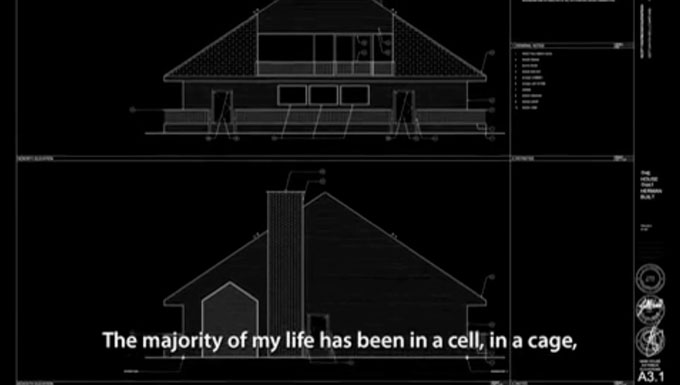
Angad Bhalla, Still from Herman’s House, 2012.
Herman Wallace may be the longest-serving prisoner in solitary confinement in the United States: he’s spent more than 40 years in a six-by-nine-foot cell in Louisiana. Imprisoned in 1967 for a robbery for which he admits guilt, he was subsequently sentenced to life in prison for a killing he vehemently denies committing. My documentary film, Herman’s House, recounts the remarkable expression his struggle found in an unusual project proposed by then New York-based artist Jackie Sumell, who invited Wallace to imagine his “dream home.” The undertaking quickly became an interrogation of justice and punishment in America.
Someone once told me that the key to a good documentary is access. Yet I somehow found myself making a film where I had no access to my main subject, Herman Wallace, or my primary location, his prison cell. At the start of this unconventional endeavor, I realized that the whole idea of “access” was crucial to the story of a man who has spent more than four decades in solitary confinement. Without access to Herman, I aimed to create a viewing experience that pushed the audience to contemplate what life in solitary would be like and, in a way, mirror Herman’s efforts at envisioning life on the outside after so many years.
The case of the Angola Three—Herman and two other men held in solitary cells in Louisiana’s Angola Prison for decades—represents a particular travesty of justice. Many believe these three Black Panther activists were targeted and tied to two separate prison guard murders to quash their dissent. But with over 80,000 people being held in solitary confinement in the United States, it would be too simple to dismiss this case as an exception.
In this first clip, we get a glimpse of how Jackie, after having written to Herman for a year, proposed the idea of working with him to design his dream home.
After our first phone call, I knew Herman’s voice would be powerful enough to carry the story. Still, we faced the challenge of deciding what to show each time Herman speaks. Working with editor Ricardo Acosta and animator Nicolas Brault, we created visuals that didn’t paper over the lack of footage of Herman, because not being able to see him was an important reminder that he was in solitary. Instead of hiding the darkness, we let the screen fade to black with him.
In this next clip, Jackie has embarked on phase two of her project with Herman, looking for land and support in New Orleans to actually build the house. She meets Malik Rahim, who introduced Herman to the Black Panther Party while they were held together in a New Orleans jail before Herman was sent to Angola. Malik knows Herman intimately and also understands Louisiana politics well. It was important that the racial tensions that surround prisons and Jackie’s position as a white artist coming from New York to support a black prisoner in Louisiana be made explicit.
While Jackie and Herman’s unique friendship is the driving force of the film, we wanted to introduce other people whose lives Herman has touched. In this clip we meet Michael, with whom Herman was able to interact during the one hour each day they were not confined to their respective cells. Unlike Herman, who is being held in solitary (and prison) for his political views, Michael’s reason for being put in solitary is more common: he was seen as a “problem” prisoner. But, as Michael explains, extended time in solitary can have a devastating psychological impact. People who do not have any mental illness when they’re placed in solitary often end up developing severe anxiety, depression, anger, paranoia and psychosis from being there.
Herman’s House opens at New York City’s Cinema Village on April 19 and will be broadcast nationally on PBS’s acclaimed series POV on July 8.
This piece, commissioned by Creative Time Reports, has also been published by Alternet.

